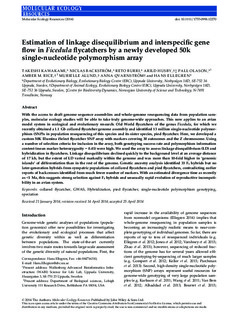| dc.contributor.author | Kawakami, Takeshi | |
| dc.contributor.author | Backström, Niclas | |
| dc.contributor.author | Burri, Reto | |
| dc.contributor.author | Husby, Arild | |
| dc.contributor.author | Olason, PI | |
| dc.contributor.author | Rice, A M | |
| dc.contributor.author | Qvarström, Anna | |
| dc.contributor.author | Ellegren, Hans | |
| dc.date.accessioned | 2014-08-29T07:05:52Z | |
| dc.date.accessioned | 2016-06-20T10:32:46Z | |
| dc.date.available | 2014-08-29T07:05:52Z | |
| dc.date.available | 2016-06-20T10:32:46Z | |
| dc.date.issued | 2014 | |
| dc.identifier.citation | Molecular Ecology Resources 2014 | nb_NO |
| dc.identifier.issn | 1755-098X | |
| dc.identifier.uri | http://hdl.handle.net/11250/2393198 | |
| dc.description.abstract | With the access to draft genome sequence assemblies and whole-genome resequencing data from population samples, molecular ecology studies will be able to take truly genome-wide approaches. This now applies to an avian model system in ecological and evolutionary research: Old World flycatchers of the genus Ficedula, for which we recently obtained a 1.1 Gb collared flycatcher genome assembly and identified 13 million single-nucleotide polymorphism (SNP)s in population resequencing of this species and its sister species, pied flycatcher. Here, we developed a custom 50K Illumina iSelect flycatcher SNP array with markers covering 30 autosomes and the Z chromosome. Using a number of selection criteria for inclusion in the array, both genotyping success rate and polymorphism information content (mean marker heterozygosity = 0.41) were high. We used the array to assess linkage disequilibrium (LD) and hybridization in flycatchers. Linkage disequilibrium declined quickly to the background level at an average distance of 17 kb, but the extent of LD varied markedly within the genome and was more than 10-fold higher in ‘genomic islands’ of differentiation than in the rest of the genome. Genetic ancestry analysis identified 33 F1 hybrids but no later-generation hybrids from sympatric populations of collared flycatchers and pied flycatchers, contradicting earlier reports of backcrosses identified from much fewer number of markers. With an estimated divergence time as recently as <1 Ma, this suggests strong selection against F1 hybrids and unusually rapid evolution of reproductive incompatibility in an avian system. | nb_NO |
| dc.language.iso | eng | nb_NO |
| dc.publisher | John Wiley & Sons Ltd. | nb_NO |
| dc.rights.uri | http://creativecommons.org/licenses/by-nc-nd/3.0/ | |
| dc.subject | collared flycatcher; GWAS ; Hybridization; pied flycatcher; single-nucleotide polymorphism genotyping; speciation | nb_NO |
| dc.title | Estimation of linkage disequilibrium and interspecific gene flow in Ficedula flycatchers by a newly developed 50k SNP array. | nb_NO |
| dc.type | Journal article | nb_NO |
| dc.type | Peer reviewed | nb_NO |
| dc.date.updated | 2014-08-29T07:05:52Z | |
| dc.description.version | publishedVersion | |
| dc.rights.holder | © 2014 The Authors. Molecular Ecology Resources Published by John Wiley & Sons Ltd. | nb_NO |
| dc.source.pagenumber | 1248-1260 | nb_NO |
| dc.source.volume | 14 | nb_NO |
| dc.source.journal | Molecular Ecology Resources | nb_NO |
| dc.source.issue | 6 | nb_NO |
| dc.identifier.doi | 10.1111/1755-0998.12270 | |
| dc.identifier.cristin | 1146121 | |
| dc.relation.project | Norges forskningsråd: 214553 | nb_NO |
| dc.description.localcode | This is an open access article under the terms of the Creative Commons Attribution-NonCommercial-NoDerivs License, which permits use and distribution in any medium, provided the original work is properly cited, the use is non-commercial and no modifications or adaptations are made. | nb_NO |

